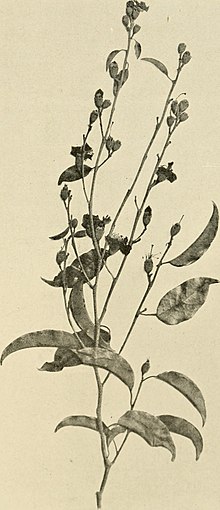Leptolaena arenaria is a tree in the family Sarcolaenaceae. It is endemic to Madagascar.
| Leptolaena arenaria | |
|---|---|

| |
| Scientific classification | |
| Kingdom: | Plantae |
| Clade: | Tracheophytes |
| Clade: | Angiosperms |
| Clade: | Eudicots |
| Clade: | Rosids |
| Order: | Malvales |
| Family: | Sarcolaenaceae |
| Genus: | Leptolaena |
| Species: | L. arenaria
|
| Binomial name | |
| Leptolaena arenaria | |
| Synonyms[3] | |
| |
Description
editLeptolaena arenaria grows up to 12 metres (40 ft) tall with a trunk diameter of up to 30 cm (12 in). Its bright green leaves are ovate in shape and measure up to 7 cm (3 in) long. The tree's flowers typically occur in inflorescences of two flowers, each with white petals. The roundish fruits measure up to 1.2 cm (0.5 in) in diameter.[4]
Distribution and habitat
editLeptolaena arenaria is known only from the northwestern regions of Diana, Betsiboka, Boeny, Melaky and Sofia.[5] Its habitat is dry forests from 50 metres (200 ft) to 200 m (700 ft) elevation. Only a few populations are within protected areas.[4]
Threats
editLeptolaena arenaria is in decline due to wildfires and the harvesting of its wood. The preliminary status of the species is Near Threatened.[4]
References
edit- ^ Rabarimanarivo, M. (2020). "Mediusella arenaria". IUCN Red List of Threatened Species. 2020: e.T69222268A69235795. Retrieved 25 October 2022.
- ^ "Mediusella arenaria (F.Gérard) Hong-Wa". World Flora Online. Retrieved 20 September 2024.
- ^ "Leptolaena arenaria (F.Gérard) Cavaco". Plants of the World Online. Royal Botanic Gardens, Kew. Retrieved 20 September 2024.
- ^ a b c Hong-Wa, Cynthia (2009). "Endemic families of Madagascar. XII. Resurrection and taxonomic revision of the genera Mediusella (Cavaco) Hutchinson and Xerochlamys Baker (Sarcolaenaceae)" (PDF). Adansonia. 3. 31 (2). Paris: Publications Scientifiques du Muséum national d'Histoire naturelle: 316–318. doi:10.5252/a2009n2a7. S2CID 84912526. Retrieved 18 October 2016.
- ^ "Mediusella arenaria". Catalogue of the Vascular Plants of Madagascar. Missouri Botanical Garden. Retrieved 18 October 2016 – via Tropicos.org.
